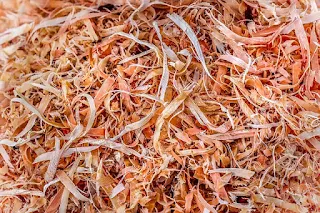Benefits of sawdust waste and its types
Kistang - Wood sawdust is a material from the wasted wood processing process. In general, sawdust is often not used. However, who would have thought that it turns out that sawdust has a myriad of benefits. One of the benefits is that your sawdust can be used to be a good planting medium for plant growth (benefits of sawdust).
5 Benefits of Wood Powder
 |
| Benefits of sawdust waste and its types |
When you are managing wood as a building material or making your fence, our advice is not to be in a hurry to throw away sawdust. Take advantage of the sawdust for various purposes that you need. The following are the benefits of various sawdust that you can use for your needs:
1. Absorbs Odors From Animal Manure
If you keep pets in your home, use sawdust as a medium to remove the unpleasant odor produced by the feces from your pets.
For example, when you raise a hamster, of course, the hamster excretes the waste products of its metabolism. Not infrequently Hamster droppings have a very strong odor. By adding sawdust in the Hamster's cage it will reduce the smell of the Hamster's droppings.
You can also sprinkle wood on other pets like cats for example,
You can mix sawdust in the litter box for cat litter at home. Wood dust can also absorb moisture as well as unpleasant odors and make the litter box not emit an unpleasant smell.
2. Become a Growing Media for Mushrooms
Mushrooms are one of the plants that can grow easily anywhere. Shitake mushroom is one of the many types of mushrooms that can be cultivated through sawdust growing media.
Use a mixture of sawdust and fertilizer with a composition of 70:30 to become a good growing medium for shitake mushrooms.
3. Processed into Briquettes
Sawdust contains a fairly low water content. Therefore, sawdust is generally used to be managed into briquettes.
For the manufacture of briquettes from sawdust, you can use sawdust from cotton stalks and sawdust from corn stalks that have been pressed to become denser, then the powder becomes a wood briquette. flammable and more durable character of briquettes.
4. Killing Wild Plants
In addition to briquettes, sawdust also has a character that can absorb moisture very quickly. You can take advantage of the sawdust that you have, as a means to kill wild plants in your yard.
For technical use, you can use the sawdust on wild plants so that the sawdust can cover the entire surface of the plant. Then let it sit for about a week. And the end result is the sawdust will absorb the water content in the soil, this makes the wild plants no longer grow.
5. Media for Planting Ornamental Plants
In addition to being a medium for eradicating wild plants, sawdust can also be used to be a medium for growing your home ornamental plants. The benefits of sawdust as a growing medium for ornamental plants can fertilize your home ornamental plants.
Wood sawdust that has been mixed with bioneensis fertilizer which has the ability to absorb high nutrients in the soil, will make the roots of ornamental plants grow better.
Wood Powder Type
Having a hobby in wood processing is a very exciting hobby, especially for you artists, who always look at the types of wood sizes to be used as materials for making art from wood. Wood is one of the easiest materials to manage into different types of creations.
You also often see a lot of sawdust that accumulates from the results of the wood processing process. Unmanaged wood waste can cause many problems if left alone. Here are some different types of sawdust waste that you can find around you. Here are some types of sawdust that are commonly found around you:
Wheat Straw
Wheat straw or more commonly known as wheat straw is a type of sawdust that is often used for the development of shitake mushroom cultivation. According to a research journal researched by Daniel J Royse and Jose E Sanchez, the use of shitake mushrooms as a planting medium for sawdust from wheat straw can increase Shitake mushroom yields up to 19% more.
Cotton Rod
The next type of sawdust comes from cotton stalks or also known as cotton stalks sawdust. Wood dust from cotton stalks is usually used for biomass fuel which is developed into briquettes.
Characteristically, cottonwood stem sawdust has a very low water content, so this causes the cottonwood stem sawdust to be more flammable and can burn for a long time.
Corn Stem
Corn stalks are a type of sawdust which in general can also be used as fuel briquettes. One of the advantages of using briquettes from cornstalk powder is that the powder can be compressed into denser briquettes, making it more durable and cornstalk sawdust has an flammable character.
Thus the article that we can present regarding the benefits of sawdust and its types.

Post a Comment for "Benefits of sawdust waste and its types"